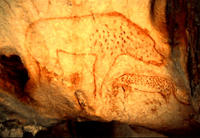You are in: Europe -> France -> Decorated Cave of Po... , and traditional search or Image Gallery will yield results of this site only
Decorated Cave of Pont d’Arc, known as Grotte Chauvet-Pont d’Arc, Ardèche
| Site number: | 1426 |
|
| Type of site: | Cultural | |
| Date: | 30000-32000BP | |
| Date of Inscription: | 2014 | |
| Location: | Europe, France, the Ardèche River in southern France | |
Up to 75 images are shown here. Click on each for more details or on Image Gallery for more images.
Six official UN languages:
Chinese,
English,
French,
Russian,
Spanish
Other languages: Basa Jawa, Bulgarian, Croatian, Danish, Esperanto, Galician, German, Hungarian, Indonesian, Italian, Japanese, Norwegian-Bokmai, Occitan, Persian, Polish, Portuguese, Sicilian, Slovenian, Swedish, Turkish, Ukrainian, Vietnamese
Other languages: Basa Jawa, Bulgarian, Croatian, Danish, Esperanto, Galician, German, Hungarian, Indonesian, Italian, Japanese, Norwegian-Bokmai, Occitan, Persian, Polish, Portuguese, Sicilian, Slovenian, Swedish, Turkish, Ukrainian, Vietnamese
| Description: | Located in a limestone plateau of the Ardèche River in southern France, the property contains the earliest-known and best-preserved figurative drawings in the world, dating back as early as the Aurignacian period (30,000–32,000 BP), making it an exceptional testimony of prehistoric art. The cave was closed off by a rock fall approximately 20,000 years BP and remained sealed until its discovery in 1994, which helped to keep it in pristine condition. Over 1,000 images have so far been inventoried on its walls, combining a variety of anthropomorphic and animal motifs. Of exceptional aesthetic quality, they demonstrate a range of techniques including the skilful use of colour, combinations of paint and engraving, anatomical precision, three-dimensionality and movement. They include several dangerous animal species difficult to observe at that time, such as mammoth, bear, wildcat, rhino, bison and auroch, as well as 4,000 inventoried remains of prehistoric fauna and a variety of human footprints. --From the description at WHC Site, where additional information is available. | |
| The Chauvet-Pont-d'Arc Cave in the Ardèche department of southern France is a cave that contains the earliest known and best preserved figurative cave paintings in the world, as well as other evidence of Upper Paleolithic life. It is located near the commune of Vallon-Pont-d'Arc on a limestone cliff above the former bed of the Ardèche River, in the Gorges de l'Ardèche. Discovered on December 18, 1994, it is considered one of the most significant prehistoric art sites and the UN’s cultural agency UNESCO granted it the World Heritage status on June 22, 2014. The cave was first explored by a group of three speleologists: Eliette Brunel-Deschamps, Christian Hillaire, and Jean-Marie Chauvet for whom it was named. Chauvet (1996) has a detailed account of the discovery. In addition to the paintings and other human evidence, they also discovered fossilized remains, prints, and markings from a variety of animals, some of which are now extinct. Further study by French archaeologist Jean Clottes has revealed much about the site. The dates have been a matter of dispute but a study published in 2012 supports placing the art in the Aurignacian period, approximately 30,000–32,000 BP. --Wikipedia. Text is available under the Creative Commons Attribution-ShareAlike License. | ||
| Source: | http://whc.unesco.org/en/list/1426 | |
| Source2: | Wikipedia (http://wikipedia.com) | |
| Reference: | 1. UNESCO World Heritage Center (http://whc.unesco.org/en/list/1426). 2. Wikipedia. | |









